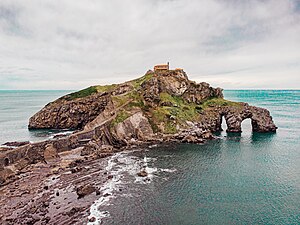Gaztelugatxe

Gaztelugatxe is an islet on the coast of the Bay of Biscay belonging to the biscayan municipality of Bermeo, in the Basque Autonomous Community. It is connected to the mainland by a man-made bridge. On top of the island stands a hermitage named Gaztelugatxeko Doniene in Basque (or San Juan de Gaztelugatxe in spanish), dedicated to John the Baptist, that late discoveries indicate might date back to the 9th century. With another small neighboring island, Aketx, they form a protected biotope that extends from the town of Bakio to Cape Matxitxako, on the Bay of Biscay.
Etymology
[edit]The basque word gaztelugatxe [ɡas̻teluɡatʃe] may have two complementary meanings, both using gaztelu ["castle"] as main subject, and differing between the sufix -atx (derived from the ancient noun haitz[1] ) ["rock"], forming "the rock castle" (-atx and its derivatives are usual in Basque toponyms related to rocky summits: Aketx, Untzillatx, Atxulo...) on one way, or -gatx[2] ["hard"/"inaccesible"], translated as "inaccesible castle" (referring to the difficulty of its conquest), in the other.
Description
[edit]

The Basque coast is rough in this area. The sea ceaselessly erodes the rocky coast creating tunnels, arches, and caves. The island of Gaztelugatxe is in the center of this section of the coast next to the small Aketx island, a sanctuary for marine birds.
Next to the hermitage, there is a small shelter with sea views that are used for picnicking and for refuge from the wind.
The hermitage is accessed by a narrow path, crossing the solid stone bridge, and going up 231 steps[1] (other sources cite the number as 229 or 237). According to legend, after the slightly strenuous climb to the top of the crag one should ring the bell three times and make a wish.
Hermitage
[edit]The small church, 80 metres above sea level,[1] dates from the 10th century. In the year 1053 it was donated by Don Íñigo López, Lord of Biscay to the monastery of San Juan de la Peña (near Jaca in Huesca). Medieval burials from the 9th and 12th centuries have been found on the esplanade and in the hermitage.
In 1593 it was attacked and sacked by Francis Drake. Among other incidents, it has caught fire several times. On November 10, 1978, it was destroyed in one such fire. Two years later, on June 24, 1980, it was re-inaugurated. The hermitage belongs to the parish of San Pelaio in Bakio.
The hermitage also houses votive offerings from sailors who survived shipwrecks.
Strategic uses
[edit]The strategic location of the site has given it an important role in historic episodes. It was one of the places where the Lord of Biscay, Juan Núñez de Lara, confronted Alfonso XI, King of Castile, in 1334.
In 1594 it was attacked by the Huguenots of La Rochelle, who sacked it and killed the caretaker. In the 20th century it was assaulted by English troops; in the Spanish Civil War the naval Battle of Matxitxako took place nearby.
Filming location
[edit]HBO filmed scenes for season seven of its fantasy series Game of Thrones at the islet.[2] Gaztelugatxe stood in for Dragonstone, with a digitally created castle on top of the islet.
Gallery
[edit]-
Gaztelugatxe, with Flag of Basque Country
-
A panoramical view of Gaztelugatxe
References
[edit]- ^ a b San Juan de Gaztelugatxe, Guggenheim-bilbao.eus, Retrieved 12 February 2017
- ^ "'Juego de Tronos' elige el entorno de San Juan de Gaztelugatxe" ['Game of Thrones' chooses the environs of San Juan de Gaztelugatxe]. EITB. 19 July 2016. Retrieved 26 July 2016. serving as the castle Dragonstone
External links
[edit]- Gaztelugatxe, Bermeo Town Council website.
- San Juan de Gaztelugatxe












